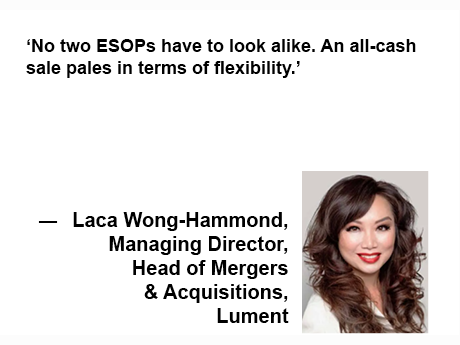Owners and operators considering an exit strategy today face a challenging economic environment. Higher interest rates have slammed capital markets. Valuations are in flux. Transactions have slowed. And the pool of potential buyers has dwindled.
As an alternative to an outright sale to a third-party, an often-overlooked option is an exit to an employee stock ownership plan (ESOP). These plans allow business owners to sell all or part of the company’s stock to employees, allowing owners to diversify wealth away from the business while limiting their future liability. Ultimately, an ESOP aligns employee interests, providing companies with a competitive advantage in recruiting and retaining highly motivated team members.
Despite the advantages, ESOPs have been widely underutilized in the seniors housing and care industry. In fact, of the approximately 6,500 ESOPs nationwide, only eight senior living companies offer an employee ownership plan.
“Seniors housing and care businesses are great candidates for ESOPs,” says Laca Wong-Hammond, managing director, head of mergers & acquisitions (M&A) at Lument, a national provider of financial solutions. “An ESOP checks all the boxes.”
Benefits include:
- Owners can defer taxes on capital gains; company enjoys meaningful tax benefits
- An opportunity to maintain equity interest in the business
- Keep operational control and direct future strategy
- Increased stability of leadership and management
- Continuation of a business legacy
- Enhanced employee appreciation, recruitment and retention
- Owners limit future liability (stock sale treatment)
A Custom Plan for All Property Types
ESOPs are highly customizable — a big advantage for owners and operators. “No two ESOPs have to look alike,” says Wong-Hammond. Typically, beneficial ownership of the company is granted over time to employees. Sellers can be paid off at once or gradually. “An all-cash sale pales in terms of flexibility,” she adds.
The entire continuum of senior living arrangements — from active adult to skilled nursing — are good candidates for the ESOP transaction structure. The business may be an operating company, real estate owner or a combination of both. Companies should have at least 20 employees (to comply with regulations) and stable and sustainable cash flows to help secure the ESOP debt, with most ESOPs involving at least some portion of seller financing.
Experience Matters
While highly customizable, ESOPs are also highly complex. Technically, an ESOP is a retirement plan regulated by the Department of Labor. The plan must also comply with IRS rules and the Employee Retirement Income Security Act (ERISA) regulations.
Company owners need a representative who understands the nuances of seniors healthcare as well as the complexities of ESOPs, according to Wong-Hammond. Lument has been involved with 75 percent of the ESOPs in the seniors housing and care industry. “We know the sector, the valuation drivers and how ESOPs work,” she says.
An ESOP is structured as an arm’s-length transaction. The Lument M&A team acts as the investment banker representing the seller of the business. An independent trustee leads the buyer’s team. Lument negotiates with the trustee to determine a fair value for the business as well as the transaction terms and structure of the ESOP financing. “It’s a rigorous, highly negotiated process,” says Wong-Hammond. “When it’s done right, it’s a win for everyone.”
A Case Study
During the pandemic, the Lument team worked with a skilled nursing owner-operator on a two-phased ESOP transaction. The company had established a strong four-decades-long legacy in its markets and was very profitable.
The second-generation owner, however, wanted to exit the sector. The Lument investment banking team explored a multitude of options. Ultimately, the owner elected to pursue a sale-leaseback of the real estate and a sale of the operations to employees through an ESOP. Key negotiating points included company valuation, seller note terms and management incentive plans.
The transaction took about five months to complete. The result? The owner received a strong interest rate on his seller notes, akin to replacement income through a tax-advantaged sale, without giving up control. A generous reward and incentive package was structured to retain and recruit employees, including those in the C-suite.
Staged ESOPs
Another option for businesses with a variety of owners is a staged ESOP or partial exit. Minority owners can be bought out to consolidate ownership. A staged ESOP also allows senior living companies that face squeezed margins to sell out a portion of the company now and the remainder at a later time when valuations improve. Despite creating an evergreen company, ESOPs can be dissolved, merged or sold.
It’s important to note that as staffing continues to be a major challenge in the senior housing and care industry, the ESOP structure provides a significant advantage. It offers employees the benefits of ownership at no cost and, when implemented successfully, can have a meaningful impact on corporate culture — compelling employees to truly think and act like owners. Workers are motivated to perform and are more likely, in a tight labor market, to remain loyal to the company because their future is tied to its success. “This industry is labor intensive,” says Wong-Hammond. “When the incentives between employees and the company’s health are aligned, the sky’s the limit,” adding, “Anything is possible.”
— By Jane Adler. This sponsored content was written in conjunction with Lument, a content partner of Seniors Housing Business.
Business owners interested in exploring the possibility of an ESOP can contact Laca Wong-Hammond at Lument.

